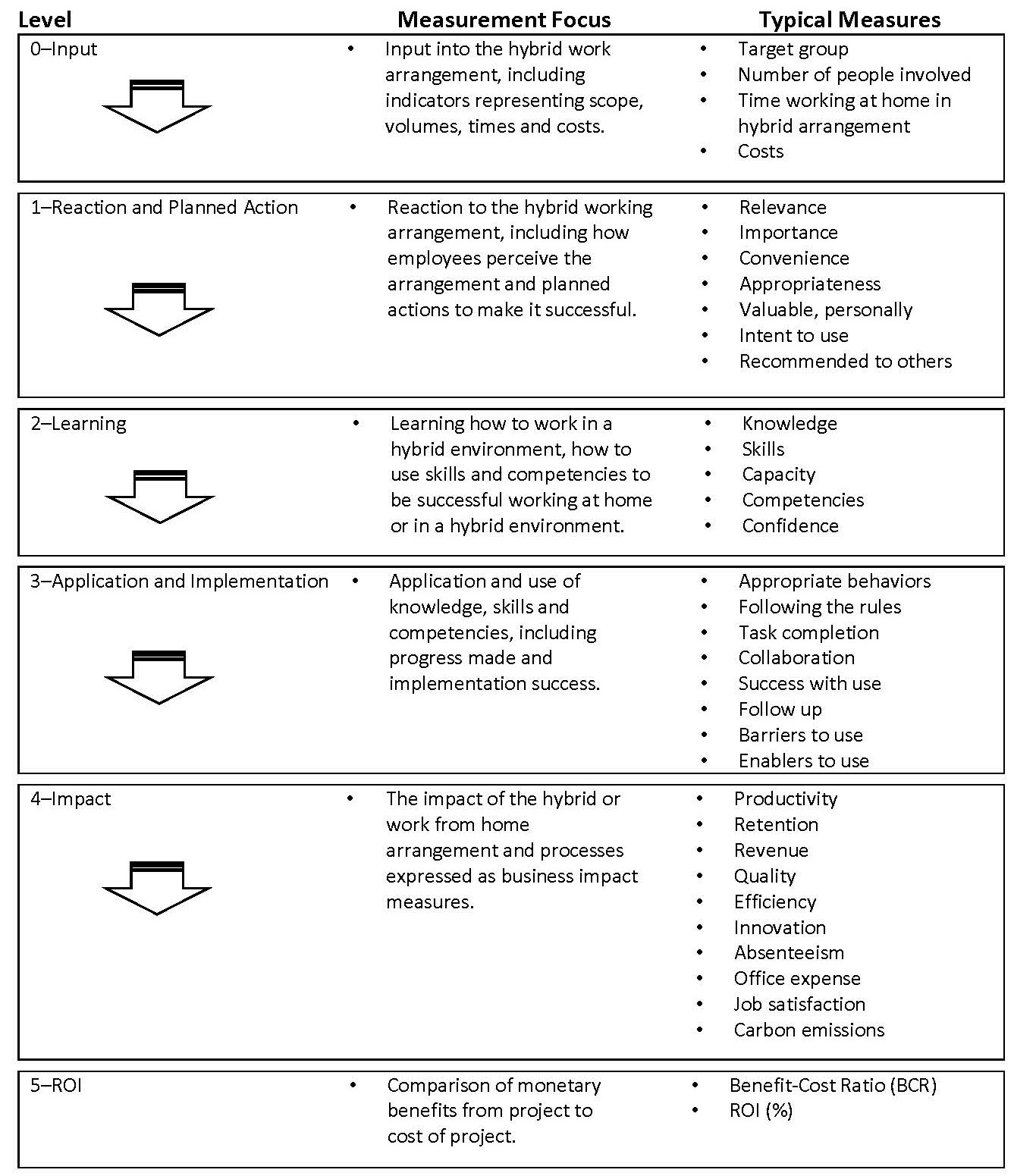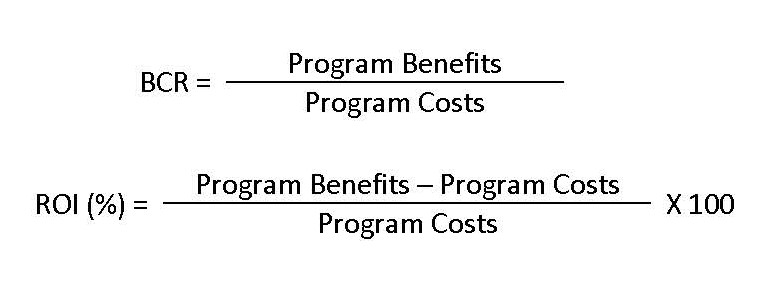Your cart is currently empty!
The ROI of Hybrid Work
By Patti P. Phillips, Ph.D., CEO, ROI Institute, and Jack J. Phillips, Ph.D., Chairman, ROI Institute
With most organizations adopting hybrid work arrangements, it is important to ensure executives see the value of working in a hybrid environment. This will require tracking the success of hybrid work, comparing it to the traditional work arrangement and examining success from three perspectives: 1) the organizations who support hybrid as an option, 2) the team members who see advantages of working in a hybrid environment and 3) the community and environment that benefit by having fewer people in traffic congestion and less pollution in the environment.
Whether it’s been in our own organization, our community, nationally or internationally, we’ve seen the evolution to remote working play out throughout the last two years. Most knowledge workers who didn’t require facing customers were forced into a remote work environment. Many individuals like it and now prefer to continue working from home. Although a few prefer to return to work in the office, most workers now want a hybrid work arrangement so they can work both at home and at the office. This arrangement is appealing because they think returning to the office full time or all remote work may not be realistic. Offering a hybrid arrangement would take care of those issues. The key is in making sure the hybrid arrangement is working.
What is missing
Most of the decisions around remote working and returning to the office have been based on polls and feedback from employees. For some executives, it’s not powerful enough, and they are demanding workers return to the office. On the other extreme, some executives are allowing the employees to essentially do what they want. There appears to be four missing pieces in this decision-making process.
- The most important data. There seems to be little data about how well remote working is working. Yes, there are data on worker and executive preferences, but not much data on how well it is working in terms of getting the work done, the impact of the work arrangement, the barriers to making it even more successful and the enablers that have made it successful. These important data sets would be valuable for the decision-making process.
- Manager input. In our work at ROI Institute, we have studied work at home arrangements for years and have found the No. 1 barrier to having employees work at home is the first level manager. These managers have a natural resistance to this arrangement. Based largely on myths: “If a manager’s physical presence is not needed, do you really need a manager? If employees can work independently, will the organization eliminate the managers? If I cannot see the work being done, then it is not happening.” If the managers don’t think it will work, it won’t work. If the managers want to make it work, it will work. These barriers need to be removed or minimized. That can usually be accomplished with proper preparation for the managers. There has been an absence of data showing how managers perceive the work getting done. If managers see the arrangement is working, and it’s driving their KPIs, then they may support this effort. Why should a top executive counter that decision and force people to return to the office?
- Senior executives are making the decisions about working at home. Many of the decisions they typically make are using the concept of ROI — costs versus benefits. ROI analysis for a hybrid work environment is rarely conducted, yet it could be powerful. The senior executive may prefer people to be in the office so they can see the work being done, the collaboration and the results. But when they realize there is a high ROI for the organization having employees work at home, this might change their thinking substantially. More ROI studies on remote working and hybrid working are needed.
- There has been almost no discussion about how working remotely is helping the environment. This is strange because most of the executives, who are making the decision to bring workers back to the office, make many statements about supporting the environment and reducing the number of tons of carbon that is forced into the environment. In ROI Institute case studies, we’ve calculated the tons of carbon not released into the environment because employees are working at home. It is dramatic and impressive. The environmental effects of working from home or a hybrid arrangement should be front and center in part of the decision-making process.
The value chain
Before showing what needs to be done, it is helpful to think about remote work as a project with a value chain tied to it. This classic logic model, first developed in the 1800s, is the basis for most evaluation systems in the world. Almost everyone can relate to it and it works. Figure 1 outlines the five levels of outcome data from a hybrid work arrangement and a level of input (Level 0).
Figure 1. The Value Chain for Remote and Hybrid Working Arrangements

Whose ROI?
In this era of stakeholder capitalism, it is helpful to think of the hybrid work arrangement from three stakeholder perspectives.
The organization’s perspective
What is the ROI for hybrid working? The ROI comes from specific impacts in business measures, isolating the hybrid solution to that impact and converting those impacts to money. That improvement in the business measures become the monetary benefits for an ROI calculation.
- Retention. Perhaps the No. 1 reason for working at home or in hybrid arrangements is to retain employees. For many employees, having this option is an important part of the decision to remain with their employer. The key is to isolate the effects of the working arrangement on their decision to stay with the organization. Because the cost of turnover is so expensive, this can result in a substantial monetary benefit.
- Office expenses. Office expenses may not be reduced in a hybrid arrangement, if a person’s desk and in-office support is maintained and kept ready for them the days they are there. However, this can be adjusted by having sharing arrangements or a hoteling concept (where people reserve an office for the days they are in the office). In those situations, the office expense reduction can be significant.
- Productivity. Studies show employees are more productive when given the opportunity to work at home or in a hybrid arrangement. Some suggest it is because they are not as stressed without their long commutes and instead are relaxed and ready to go to work. Another possibility is that employees work harder to try to be more productive, so they can keep this arrangement. Additionally, working at home can be a distraction-free environment and may enable individuals to have more productivity without the constant interruptions of the office.
- Absenteeism. Sometimes employees are absent because they need to take care of personal issues, such as a brief doctor’s appointment or a personal errand. Instead of taking a day off, they can usually work these into some portion of their time at work. Also, sometimes employees may not feel well at the beginning of the day. Later in the day they may feel better and decide to work at home. If they had to go to the office, they may choose to just take a sick day.
- Quality of work. For some types of work, there may be fewer mistakes and errors because of the focus and distraction-free environment.
- Intangibles. There may be many other intangibles, such as job satisfaction, work-life balance, engagement, convenience, stress, and recruiting image.
The key is to capture these impacts, convert them to money, and compare them to the costs of the working arrangements. Costs could be minimal, or extensive, particularly if the organization has spent money setting up a work from home arrangement for an employee or providing support at home with some of their work. The key is to capture all the costs. ROI is calculated using two formulas, the benefit-cost ratio (BCR) and the ROI calculation.

The employee perspective
This won’t necessarily require an ROI calculation, but collecting the advantages from the employee perspective compared to any disadvantages is beneficial. Again, if the employee prefers a hybrid arrangement, there should be job satisfaction, work-life balance, convenience, and personal cost savings for commute time, parking, and meals. Part of the feedback from employees could be asking: “Is this a good return on investment for you?” You should receive a positive response to that question.
The environmental perspective
The environment includes the community. City mayors want less traffic and congestion and will reward, recognize and promote the concept of working at home. They often give awards for organizations who offer these options and take the steps to implement these arrangements. Because of congestion challenges, some will even provide incentives for offering a work at home option. Just imagine in the most congested cities of Los Angeles, New York, Washington DC, and Atlanta, what it would mean to those cities if a large part of their employees worked at home.
When examining the effect on the environment, calculate the fuel savings for employees. It’s a plus for them on the monetary side, but it also shows a reduction in fuel burned in the travel commute. This can be converted to the tons of carbon prevented from going into the environment. Some environmental supporters suggest the single, most important thing a company can do to help the environment is to allow its employees to work from home.
For a copy of an ROI study following the process outlined in this article, please contact us.
This article was originally published on March 15, 2022, at Talent Management.


























